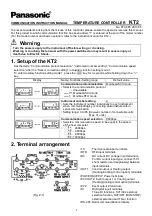
CLS200 Series User’s Guide
Chapter 8: Troubleshooting and Reconfiguring
140
Troubleshooting Controllers
A problem may be indicated by one or more of several types of symptoms:
• A process or deviation alarm
• A failed sensor alarm
• A system alarm
• Unexpected or undesired behavior
The following sections list symptoms in each of these categories and suggest possible causes and
corrective actions.
Process and Deviation Alarms
When a process or deviation alarm occurs, the controller switches to the single loop display for the
loop with the alarm and displays the alarm code on the screen.
Table 8.1
—
Controller Alarm Codes for Process and Deviation Alarms
CODE
ALARM
DESCRIPTION
HP
High Process
Process variable has risen above the high process alarm setpoint.
HD
High Deviation
Process variable has risen above the setpoint by more than the
deviation alarm value.
LD
Low Deviation
Process variable has dropped below the setpoint by more than the
deviation alarm value.
LP
Low Process
Process variable has dropped below the low process alarm setpoint.
Responding to Process and Deviation Alarms
In a heating application, a low process or low deviation alarm may indicate one of the following:
• The heater has not had time to raise the temperature.
• The load has increased and the temperature has fallen.
• The control status is set to manual instead of automatic.
• The heaters are not working due to a hardware failure.
• The sensor is not placed correctly and is not measuring the load’s temperature.
• The deviation limit is too narrow.
• The system is so poorly tuned that the temperature is cycling about setpoint by more than
the alarm setpoint.
NOTE!
In cooling applications, similar issues cause high process and high deviation
alarms.
Содержание CLS200
Страница 1: ...CLS200 User s Guide...
Страница 193: ...CLS200 Series User s Guide 193 Declaration of Conformity...
















































